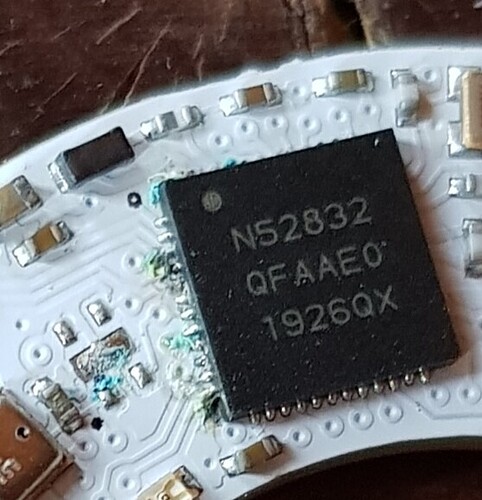Hi there!
One of my new (autumn 2020) ruuvitags spent the winter with the roses in their shelter (spunbond+snow). It was in a non-air/water-tight plastic box. The temps there were around 0 celsius, humidity close to 100%. Not the best conditions but one of my old ones (2017) spent three winters there and is still alive and kicking.
Ok, so about a month ago it stopped showing any signs of life. Now that the snow is gone I took it out, there was quite a bit of water in the outer box but none within the tag itself - maybe a couple really tiny drops on the walls. I removed the battery and inserted it back - no signs of life. I checked the voltage: around 1.9V on the battery with no load and around 1.5 when in the tag. Ok, goodbye battery. I insert a good battery, the red light immediately goes on and stays on. The tag is not on air - not visible by nrf connect, neither as its old self nor as ruuviboot. Doesn’t react to single button presses but when I press both buttons the light goes off. Then if I press R button it goes back on. Not on air in any state.
So, is it done for good?
Happy end: I looked at the PCB and noticed some oxidized copper-ish coloring along the main chip that I didn’t like.
I washed the problem parts with alcohol, tried to remove the rest of solid dirt with a toothpick then dried it.
Et voilà: now it works, no firmware replacement was needed.
I guess I should better cover the problem parts with some - whatdoyoucallit - varnish? before putting it back into humid conditions? What product should I use?
I have used likes of Spray - a protective paint for PCB PLASTIK 70 - 400ml | GM electronic COM .
If you decide to spray PCB, be sure to cover the BME280 vent and battery contact terminals first. BME280 is going to show wrong values if there is condensation. It’s possible that some contaminants will find their way into sensor element if there is water inside the BME280, in which case the inaccuracy will be permanent.
Thank you - will try!
From a Bosch document I came across a few days ago:
Forbidden is the exposure to chemicals. It shall be avoided that the sensor gets in close contact with volatile chemicals such as solvents or other organic compounds in high concentration and long exposure. Toluene, Acetone, Ethanol, Ketenes, Isopropyl Alcohol, etc. are identified to effect drift of the humidity reading –permanent damage of the sensor readings is very likely in most of these cases. It is important to know that the referred materials to are ingredients for adhesives, epoxies, glues, etc. and outgassing during re-conditioning bakingand curing. These chemicals are also added as plasticizers into plastics, used for packaging materials, and outgassing for a limited time. Bases and acids can damage the sensor permanently and shall be kept away from the sensor. Examples for such chemicals are NH3, NaOH, HCl, H2SO4, HF, HNO3, H2S2O7etc. Additionally O3in high concentration or H2O2have the same effect and is not recommended.
